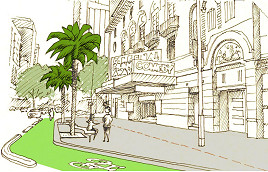If you can’t stand the heat …
By Shane Scanlan
Known as the “urban heat island effect”, the masses of concrete, steel and bitumen in the central city draws and retains heat like no other place in the state.
Other inner city locations get as hot as the CBD on any given day.
But our thermal mass dictates that the heat is retained for longer, meaning higher overnight minimum temperatures and increasingly-oppressive nights during heat waves.
According to City of Melbourne environment chair Arron Wood, the solution is multi-faceted, but can be summarised as “greening”.
Deciduous trees, which drop their leaves to allow vital winter sun but provide a canopy in the summer, is the first line of defence.
Greening walls, rooftops and facades comes next.
The heat island effect disadvantages the CBD over-and-above the effect of global warming and we are particularly vulnerable should our plane trees die from disease or in the next prolonged drought.
Contemporary council policy dictates that no more than 5 per cent of a single species be planted in a specific area.
This is to protect against species-specific diseases which can wipe out every tree in a location.
But in the CBD, we have a mono-culture of plane trees … and more plane trees.
Cr Wood said plane trees were susceptible to extreme heat and their leaves literally burned off.
The effect looks like an early autumn, except the leaves just die and don’t necessarily drop.
“Without enough water, their leaves shrivel and die and this is only going to get worse with rising temperatures,” Cr Wood said.
He said that, with a conservatively-predicted average rise in temperatures of two degrees by the end of century, Melbourne’s climate would resemble current-day Mildura’s.
So, keeping water up to the city’s “urban forest” is a vital cog in a complex wheel of survival.
Water sensitive urban design (WSUD) is an engineering solution that results in the harvesting, storage and re-use of storm water.
Cr Wood explained that only 1 per cent of the 500 billion litres of rain that falls on the City of Melbourne each year was retained.
The council is becoming more technically competent in engineering options which nurture more trees throughout our long summer.
And there are plenty of hardcore reasons to embrace a “greening” agenda apart from simple aesthetics which, back in 1977, Victorian’s celebrated with the slogan “Garden State” on motor vehicle number plates.
Cr Wood pointed out that heat stress kills more Victorians each year than the road toll.
He said that, in the week leading up to the Black Saturday bushfires in 2009 (which claimed 170 lives), some 370 Melburnians died from heat stress.
He also said January 2014’s five-day heat wave cost CBD retailers $50 million in lost revenue because shoppers simply stayed away.
“And that’s not to take into account construction industry losses where workers stay home when the temperature hits 35 degrees and disruption to schools, kindergartens and childcare centres,” Cr Wood said.
“So, we’ve had heat waves of three, four or five days,” he said.
“But what happens when these events extend to two weeks or more?”
“We’re heading for Mildura-type weather, where they get 10 or 12 days in a row of over 40 degree temperatures.”
Cr Wood said the council had a series of intersecting policies to combat the effects of urban heat islands.
These include social strategies, open space strategies, urban forest strategies and climate adaption strategies.
He said hard surfaces, such as footpaths and roads, needed to be permeable so precious rainwater could be retained in the underlying soil.
He also said the council intended to double the current city tree canopy by 2040 by planting 3000 new trees every year.
And he said Melburnians needed to get used to the reality that the city’s iconic heritage trees were approaching the end of their natural lives.
“Some of our classic parks and gardens will be unrecognisable without the elms and oaks,” he said.

Council endorses office tower at Flinders Lane despite querying car park demolition



 Download the Latest Edition
Download the Latest Edition